SUNDAY
JUNE 30 - 2013
EMSWORTH
Plants
Jean and I went for a
morning stroll through Emsworth. Passing through
Bridge Road car park we stopped to look at the two
Bee Orchids that Jane Brook and I found there
last Monday and found another one in flower close to
the others. It's amazing how these plants just pop up
unexpectedly. We had a Bee Orchid on the New Brighton
Road Junction wayside last year, but there's no sign
of it this year. Also, on the Bridge Road verge, the
Sulphur Cinquefoil is now looking very good
with three flowers fully open and more to come.
Here is a fine example
of Moth Mullein in flower on the east bank of
Peter Pond. Ralph Hollins corrected my original
identification of the plant 'Dark Mullein'. The size
of the flowers and they way they are widely separated
on the stem indicates it is a Moth Mullein. As always,
Ralph is spot on and I am always grateful to him for
checking my blog for errors. Blamey, Fitter and Fitter
describe Moth Mullein as 'stickly hairy only above'
which can be seen on today's photo of the plant.
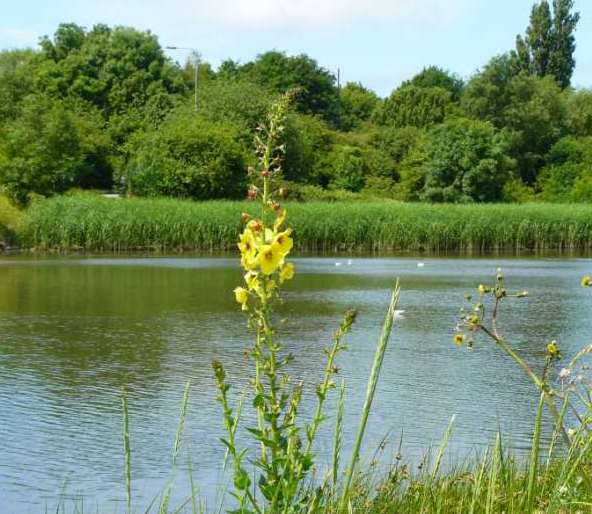
Butterflies
We saw two Speckled
Woods on the Dolphin Creek wayside. Then on Brook
Meadow we had yet another Small Tortoiseshell -
sunning itself on the gravel path north of the north
bridge on Brook Meadow. This is the 4th Small
Tortoiseshell I have seen here in the past week or so.
Let's hope this indicates a revival in the fortunes of
this once very common butterfly.
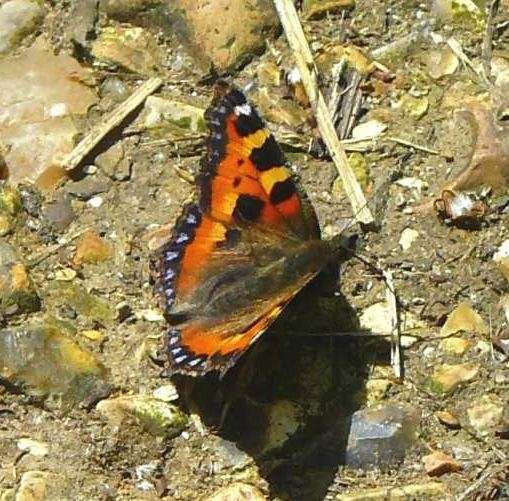
Water
Voles
While we were standing
on the small footbridge on the Lumley Path, Jean and I
watched a small brown mammal swim across the Lumley
pool. We did not get a good look at it but it swam
like a Water Vole and almost certainly was not a rat.
We met Malcolm Phillips on Brook Meadow. He had
already seen what was probably the same adults and
youngster that he saw yesterday from the south bridge.
Birds
Malcolm also saw a
Moorhen with a family of 4 chicks by the sluice
gate. Here is Malcolm's shot of three of the chicks.

OTHER
NEWS
Orchid
count
Nigel Johnson and his
team from the Havant Wildlife Group counted 7,420
Southern Marsh Orchids on the South Moor at Langstone
on Saturday morning. This is a good number, but
continues the downward trend over the past 3 years
from a high of 9,234 in 2010. Here is Derek's photo of
the counting team taking a break.
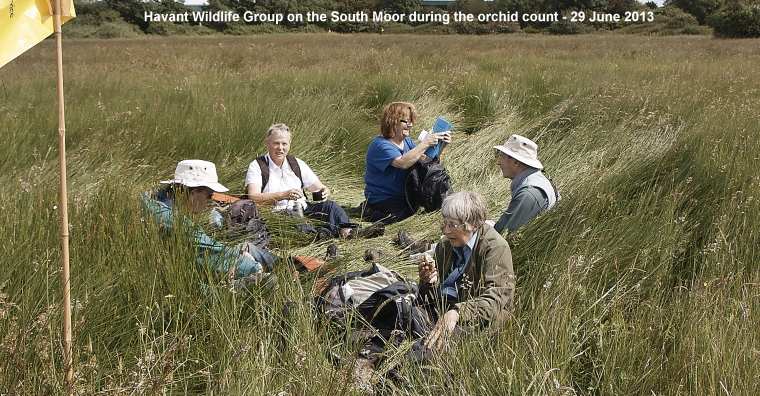
SATURDAY
JUNE 29 - 2013
EMSWORTH
Mute
Swan news
The Mute Swan family
from the Peter Pond nest was on Slipper Millpond this
morning with their 3 remaining cygnets. Interestingly,
while I was present the swans and the cygnets swam
within a metre of the centre raft where both of the
adult Great Black-backed Gulls were present with their
chicks, but the gulls took absolutely no notice of
them at all. This is good news for the cygnets. I
think the sluice gates are more of a threat to the
cygnets than the gulls at present.

The Mute Swan family
with their 3 cygnets (including the white (Polish)
one) from the marina nest was in the main low water
channel in the eastern harbour. But there was no sign
anywhere of the 2 cygnets from the Peter Pond family
that went over the sluice gates in the past two days.
I assume these will now have been swept out to sea
with the tide and perished.
Meanwhile, the pen
Mute Swan was on the town millpond with its
scraggy-necked cygnet. The cob was driving off other
swans that were nearby.
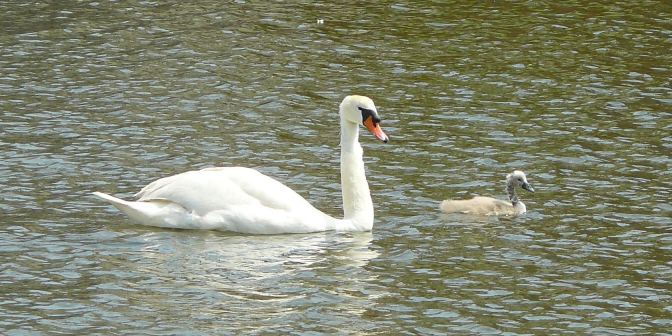
Plants
on beach
There were, as usual,
a good variety of plants on Emsworth east beach near
the steps. They included both Spear-leaved Orache and
Grass-leaved Orache and my first flowering of
Perennial Sow-thistle (or Corn Thistle as
Blamey, Fitter and Fitter prefer to call it). I have
included a leaf in the photo as added proof of the
identity of this plant.
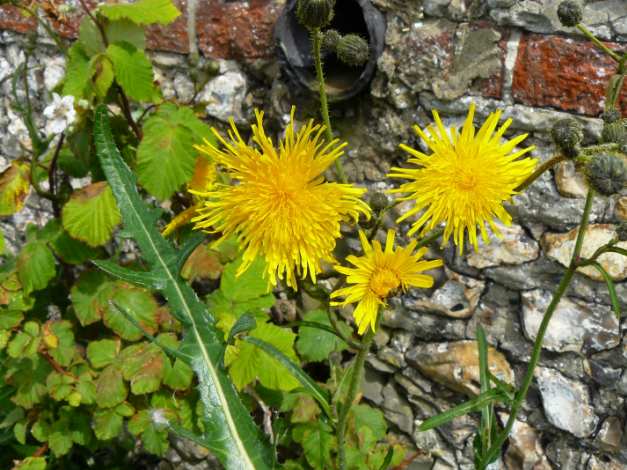
Water
Voles with young
Malcolm Phillips is
back from holiday and was on Brook Meadow today seeing
Water Voles. The first sightings we have had since he
went! From the south bridge he saw two adults and a
youngster. Here is Malcolm's photo of the youngster.
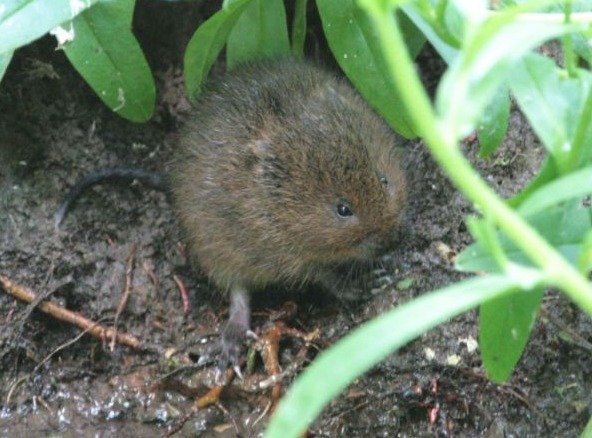
FRIDAY
JUNE 28 - 2013
MILLPOND
NEWS
Swan
cygnet drama
There was a mini drama
on Slipper Millpond this morning when two of cygnets
from the Mute Swan family from the Peter Pond nest got
caught in the strong current of the outgoing tide and
were swept over the sluice gate of Slipper Millpond
and into the low water basin below. Watched by an
admiring audience, a 'local hero' named Roger
clambered down to bring them back. He managed to catch
one of the cygnets and put it back on the pond with
its parents, but the other cygnet swam off into the
main harbour. Well done, Roger!

The Mute Swan pair
continued to hang around the fast flowing sluice with
their three remaining cygnets, much to the
consternation of the people watching, but eventually
they all moved off to the other end of the pond.

Interestingly, the
swan pair were left with only 3 cygnets, which means
they must have lost another one since yesterday when
they had five. This missing cygnet must have been the
one that Maurice Lillie saw yesterday afternoon join
the marina family of three cygnets (including the
white one) in Dolphin Lake. It too must have gone over
the sluice gate. Maybe, the one that escaped into the
harbour today will also join the marina family to make
five? I would be grateful for any further observations
of the the Mute Swan families.
Sandwich
Tern
Far less dramatic was
the presence of a solitary Sandwich Tern sitting on a
yellow buoy in the centre of the town millpond this
morning. Terns are uncommon on the millpond.
OTHER
NEWS
Burnet
Moths
Regarding the 5-spot
Burnet Moths I saw on the Lillywhite's patch
yesterday, Ralph Hollins says they were most likely to
be 'Narrow-bordered 5-spots' which are now far more
common in Hampshire than the 5-spots. For more on
these two moths, Ralph referred me to the Hants Moths
web site at . . . http://www.hantsmoths.org.uk/moth_list.htm
THURSDAY
JUNE 27 - 2013
EMSWORTH
Brook
Meadow
The Great
Burnet is still looking good on Brook Meadow with
about 20 bright red flower heads on 6 plants in all.
Interestingly, all the flowers on Great Burnet are
bisexual with 4 short stamens and an undivided stigma.
These can just be seen opening at the top of the
flowerhead in the photo. In contrast, the upper
flowers of Salad Burnet are female with 2 red-purple
feathery stigmas; the male flowers are in the lower
part of the flowerhead. That confirms the
identification of this plant as Great Burnet and not
Salad Burnet.
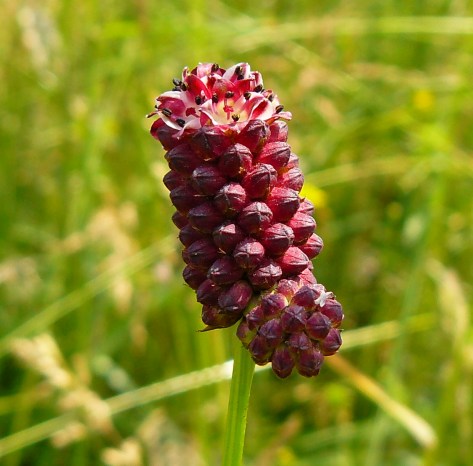
I had a very close encounter with a female Banded
Demoiselle by the Lumley Stream.

Lillywhite's
patch
I had a mooch around
on this patch of grassland to the west of Peter Pond.
It is owned by Lillywhite's Garage, but since it is
adjacent to Brook Meadow I usually include it in
meadow surveys. Today, I found lots of Smooth
Tare, distinguished from Hairy Tare by having pods
with 4 seeds and not 2 and more (1-2) larger flowers
in the head. There were also good number of 5-spot
Burnet Moths feeding on Meadow Vetchling.
CORRECTION
Ralph Hollins says the
5-spot Burnet Moths were most likely to be
'Narrow-bordered 5-spots' which are now far
more common in Hampshire than the 5-spots. For more on
these two moths, Ralph referred me to the Hants Moths
web site at . . . http://www.hantsmoths.org.uk/moth_list.htm
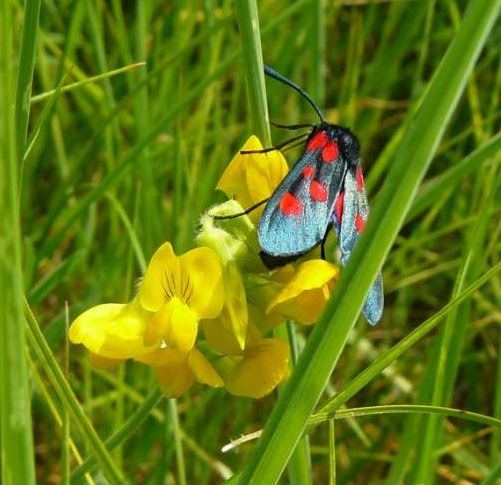
I also had a 'Nursery-web spider' (Pisaura
mirabilis) guarding its nest of spiderlings.
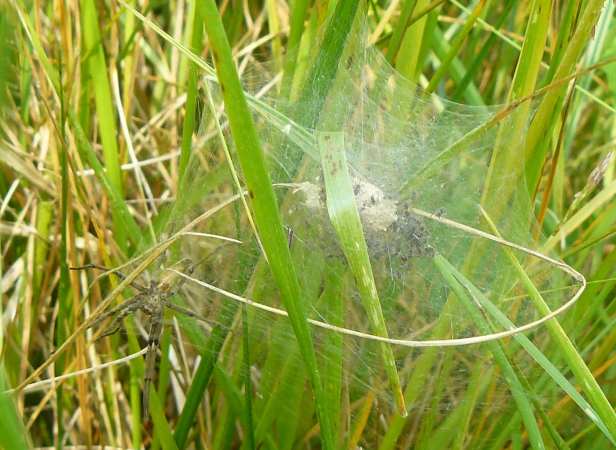
Peter
Pond
I could hear 2 Reed
Warblers singing on Peter Pond, one from the main
reedbeds to the north of the pond and the second from
the reeds in the south west corner of the pond.
Shaggy Soldier is flowering on the traffic
island on the A259 opposite Peter Pond. It also
flowered here last year.

Slipper
Millpond
The Mute Swan family
of pen and 5 cygnets, all feeding quite nicely, was in
the north west corner of the pond near the Chequers
Quay estate.
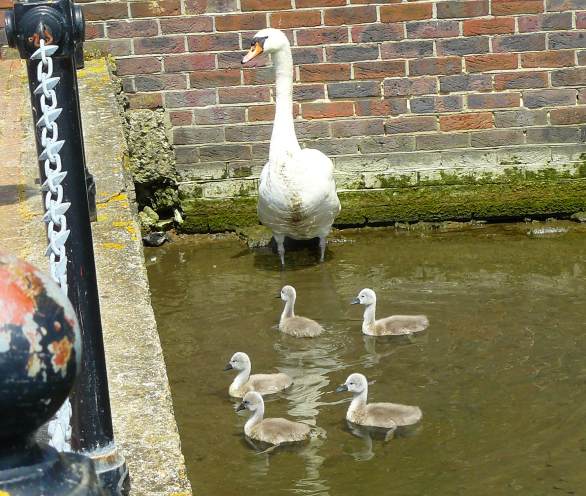
Dolphin
Creek
I checked this wayside
where I found a good growth of Saltmarsh Rush
for the first time. Here is a specimen held up with
the creek in the background.
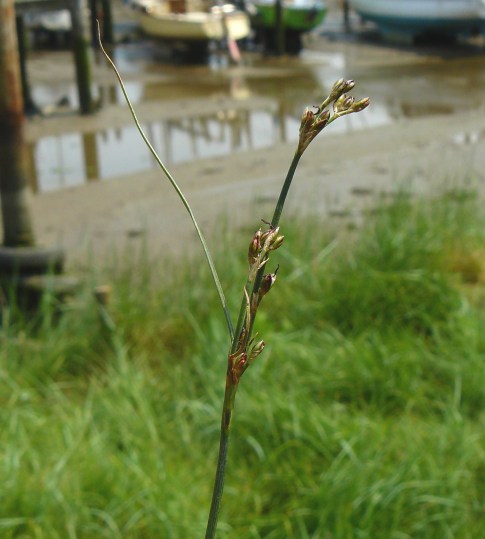
OTHER
NEWS
Wolf
Spider
Peter Milinets-Raby
has been taking photos of creepy crawlies in his
garden. Here is a dramatic one he sent to me showing a
fearsome Wolf Spider catching a small fly.
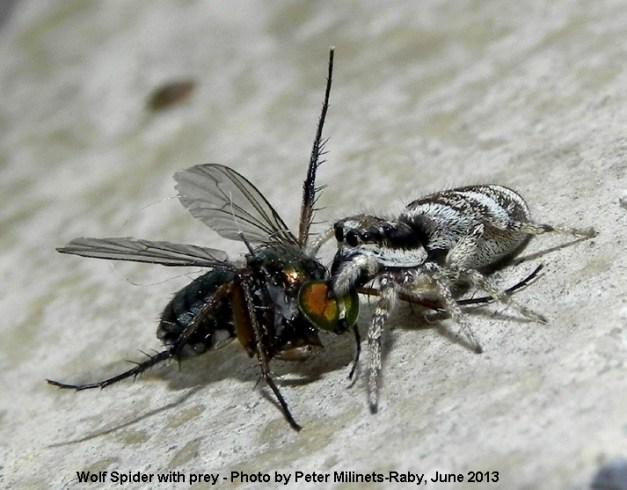
From Wikipedia I learn
that Wolf Spiders are members of the family Lycosidae
and there are an astonishing 2,300 species around the
world, some with venomous bites! They are robust and
agile hunters with excellent eyesight. They live
mostly solitary lives and hunt alone. Some are
opportunistic hunters pouncing upon prey as they find
it or even chasing it over short distances. Some will
wait for passing prey in or near the mouth of a
burrow. They resemble the more familiar Nursery web
spiders (family Pisauridae) - see previous photo, but
wolf spiders carry their egg sacs differently.
WEDNESDAY
JUNE 26 - 2013
MILLPOND
NEWS
Emsworth
Millpond
I know a lot of people
are anxious about the scraggy-necked cygnet from the
"litter nest" on the millpond. Well, this morning, I
found the whole family, pen, cob and youngster, some
way up on the millpond. All three were feeding and the
adults were stirring up the muddy floor of the pond
for invertebrates for the cygnet. As for the 'litter
nest' it looked totally deserted and it seems as if
the pen has finally given up brooding the addled eggs.
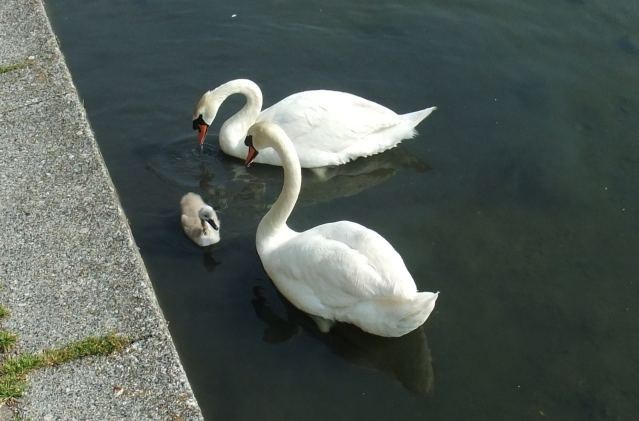
The regular growth of
Yellow Oat-grass was showing well along the
uncut grass verge on Bath Road. Alas, the verge was
cut when I passed by this afternoon! Quick work. But I
picked a few stems for my wildlife vase before they
were strimmed to oblivion.
Slipper
Millpond
There was no sign of
the Mute Swan family when I visited the pond this
afternoon. Nor were they on Peter Pond. I have to
assume they must have gone over the sluice gate into
the harbour at high water. A sensible move, to get as
far away from the Great Black-backed Gulls as
possible.
NORE
BARN
Wet
field
Having read Bob
Chapman's blog about finding Sea Clover and Sea Barley
at Farlington, I cycled over to Nore Barn to see if I
could find them there. Ralph Hollins did find a growth
of Sea Clover in June 2009 on the wet field
west of the woods, but as far as I am aware it has not
been seen there since then. I had a look around this
field, but it had cattle grazing and they had eaten
virtually everything of any interest. There was
certainly no sign of any Sea Clover. I did find some
barley, but it was Meadow Barley and not Sea
Barley. One Meadow Brown was my sole butterfly
of the morning!
Saltmarshes
Lesser
Sea-spurrey was in flower with the sepals longer
than the petals. There was also a few patches of
Common Sea-lavender, but not as much as I would have
expected. No sign of any Lax-flowered Sea-lavender.
The most eye catching plant on the saltmarshes west of
the stream was Red Fescue grass with red
panicles, which it does show when growing near the
sea, according to Rose. Some panicles were open and
others remained closed despite showing anthers.
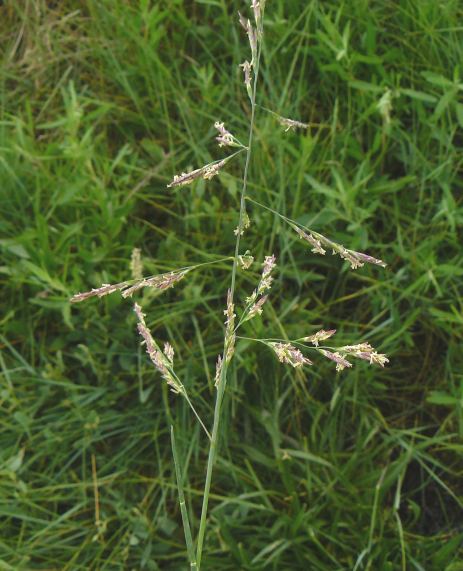
I found some
English Scurvygrass in flower. I had a close
look at the basal leaves which were wedge-shaped
tapering into the stalk as were those Bosham Harbour
last week, which I thought looked like Common
Scurvygrass. Some bright green Glasswort was
showing well, but no sign of any flowering of Golden
Samphire as yet.
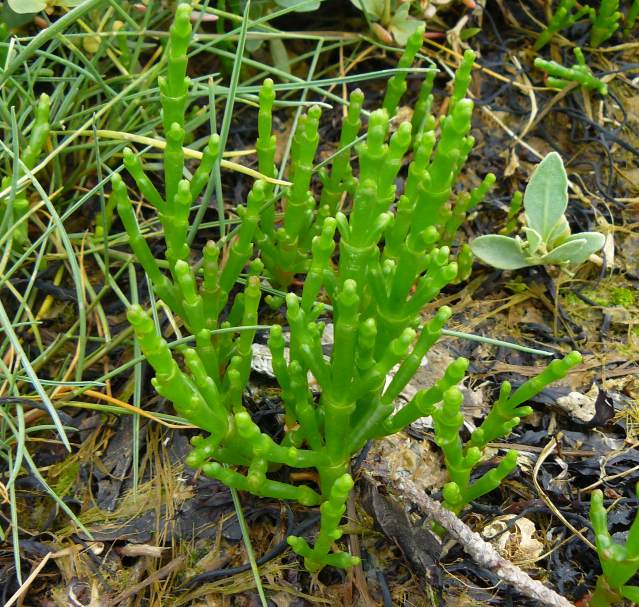
Nore
Barn Woods
I found a Tutsan bush
in flower in the middle of the woods. False Brome
grass is starting to open on the west side of the
woods. Rough Chervil was common on the path
west of the woods with rough stems turning red. Grid
Ref: SU 73595 05176.
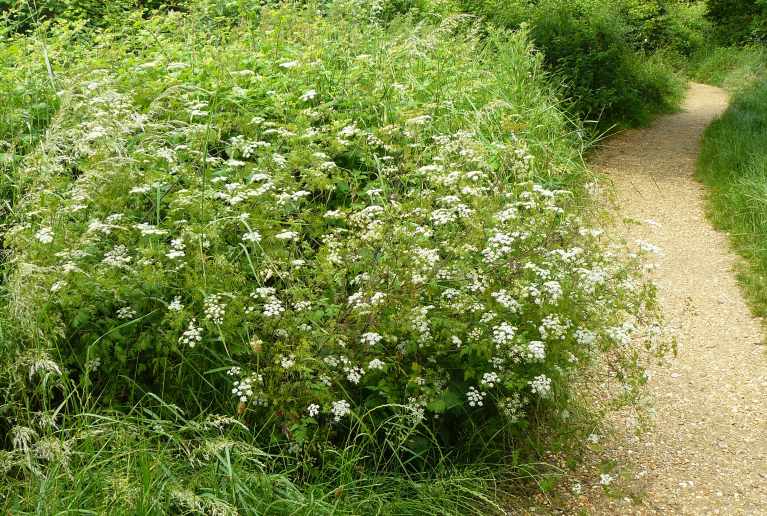
OTHER
NEWS
Bumblebee
numbers
I seem to be seeing
lots of Bumblebees around this year. So, I asked our
Bumblebee man Bryan Pinchen if he thought they were
having a particularly good year. He thought bumblebee
numbers had been really low this year, until yesterday
when he was out surveying and saw ten species! But
most were males feeding on flowers and looking for
queens to mate with and so are usually more evident.
TUESDAY
JUNE 25 - 2013
MILLPOND
NEWS
Emsworth
Millpond
The surviving Mute
Swan cygnet was on the water with its mother this
morning, but is still looking scraggy about the neck
and needs some natural high protein insect food to
develop properly. The pen was doing her best by
stirring up the mud at the bottom of the pond to
release invertebrates to the surface for the
youngster, but it is still very much 'fingers crossed'
for its future. I get the impression that the pen was
not all that keen to get back on the 'litter nest'
with the cygnet, which is good news, though the cygnet
did clamber up onto the nest while I was there.
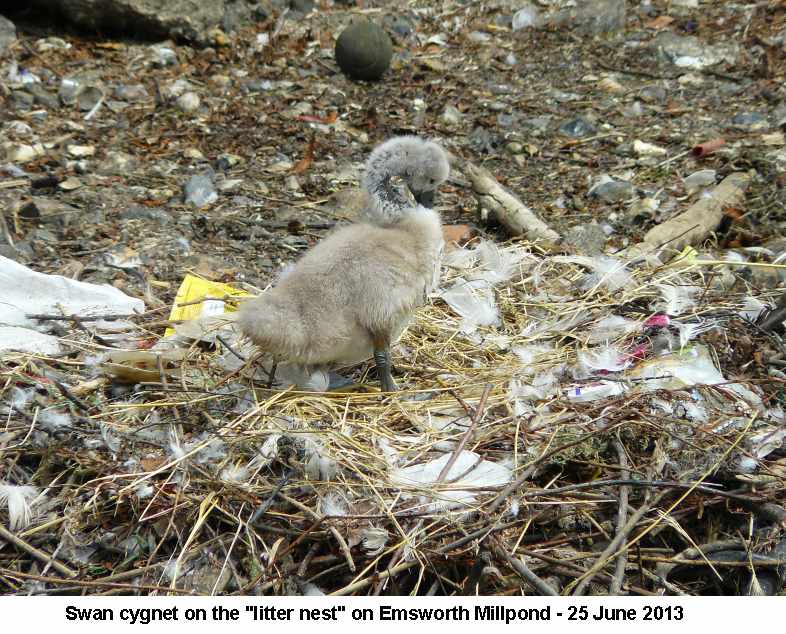
Slipper
Millpond
There is no change in
the Mute Swan family from yesterday with all 5
cygnets present and looking healthy. This pen was also
stirring up the mud at the bottom of the pond for her
cygnets, just like the millpond one. Good mothers?
Maybe, but I would be happier to see the swan family
back on Peter Pond, away from the Great Black-backed
Gulls.
Tom Bickerton told me
about a violent confrontation he witnessed over
the weekend between the Great Black-backed Gulls on
the centre raft and a visiting Cormorant. The match,
of course, was quite unequal and the Cormorant was
driven off with 'its tail between its legs'.

Tom also saw one of
the gull chicks taking a Coot chick 'in one gulp'.
That must have been one of the Coot's second broods. I
wonder if they could get a cygnet down in one gulp?
Interestingly, Tom says with the arrival of large
shoals of cuttle fish in the harbour, there is
actually plenty of natural food for the gulls, though
the presence of a live Coot chick nearby is clearly
beyond their temptation. Tom thinks stopping feeding
of the Coots and swans would help, but there is no way
to control this.
MONDAY
JUNE 24 - 2013
WAYSIDES
NEWS
Jane Brook and I
carried out our regular Monday morning survey of the
Emsworth waysides.
New
Brighton Road Junction
We started at the New
Brighton Road Junction where we added 12 new plants to
take this year's list for this wayside to 49 species
(grand total over the years is 90). Creeping
Bent-grass was in flower for the first time. We
also found a small patch of low growing moss like
plant which I think must be Procumbent
Pearlwort, though the leaves are very fleshy.
Confirmation would be appreciated.

Railway
Wayside
Moving to the Railway
Wayside we looked first at the barren area of ground
on New Brighton Road outside the metal gate. There we
examined the two remaining spikes of Black Grass
which were still showing well.
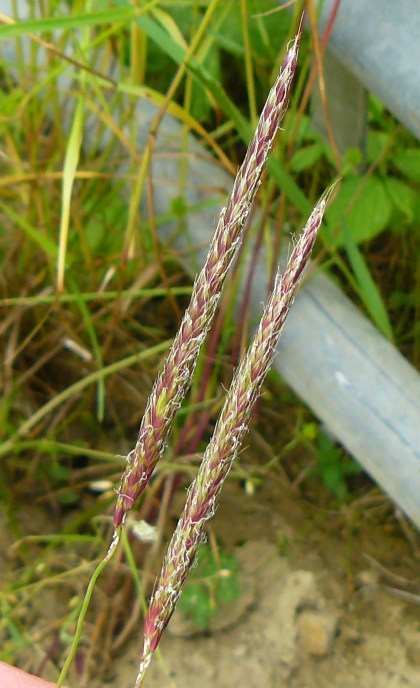
Hoary
Willowherb is now in flower, not only inside the
small fenced area in front of the large advertising
poster, but also outside the railings along the edge
of the road.
Other plants in flower
on this wayside were Hairy Sedge, Selfheal, Tufted
Vetch, Hedge Bindweed, Wild Carrot, Meadow Vetchling,
Common Knapweed, Spear Thistle, Creeping Bent-grass.
The plant list for this year alone stands at 120 for
the Railway Wayside with 161 on the complete list
including last year.
Long
Hoverfly
We also found a tiny
hoverfly with yellow and black bars across its abdomen
which I don't recall having come across before. It was
feeding on the Field Forget-me-nots. I have
tentatively identified it as a male Long Hoverfly
(Sphaerophoria scripta). The insect gets
its common name from the fact that the male shown here
has a body longer than its wings. It is common over
much of Britain.
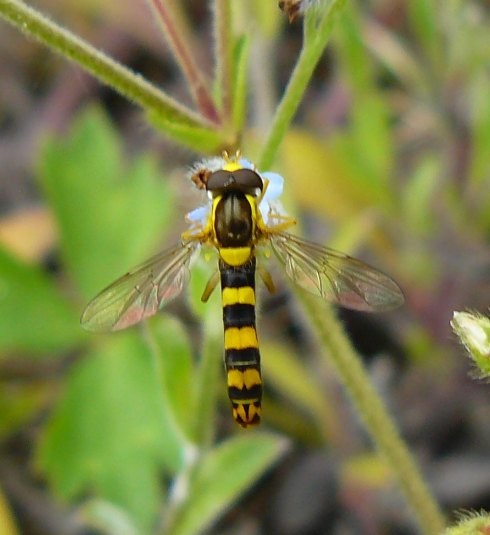
Bridge
Road Wayside
We were delighted to
discover two Bee Orchids in flower on the grass
verge just north of the Goat Willow tree - the first
ever Bee Orchids on the Bridge Road Wayside. However,
one plant which does not seem to be present this year
is the rare Narrow-leaved Water-plantain which grows
in the Westbrook Stream. I fear the heavy rains were
had earlier in the year may have washed. However, I
will get down into the stream sometime to have a good
look around.
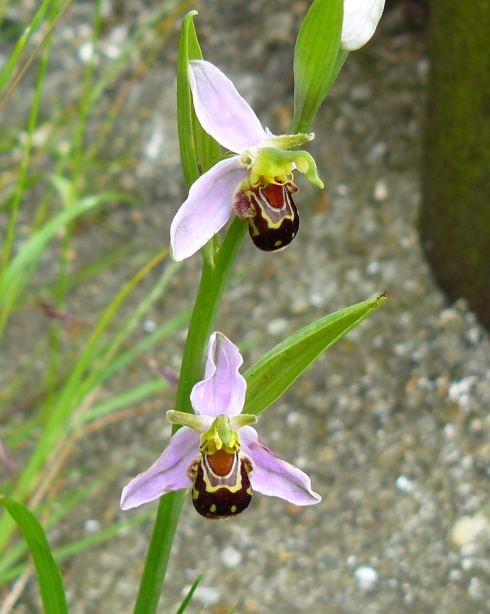
MILLPOND
NEWS
Emsworth
Millpond
The Mute Swan and her
one cygnet were on the water at the top of the
millpond and not on the 'litter nest' which had just
two eggs visible. Hopefully, the pen has finally given
up brooding them. While I was there, I saw the pen and
the cygnet swimming into the tunnel under the main
road. The culvert leads through to Bridge Road
Wayside. I have seen swans in previous years come
through to feed on the lush vegetation of the wayside,
but that is no longer possible as a new grill has been
installed at the end of the tunnel preventing access
to the stream in the car park.
Slipper
Millpond
The Mute Swan family
from the Peter Pond nest were on Slipper Millpond
again this afternoon, but the brood was down to 5
cygnets from the 6 that were here yesterday. As
before, I suspect the lost cygnet has been taken by
the Great Black-backed Gulls that are nesting on this
millpond.
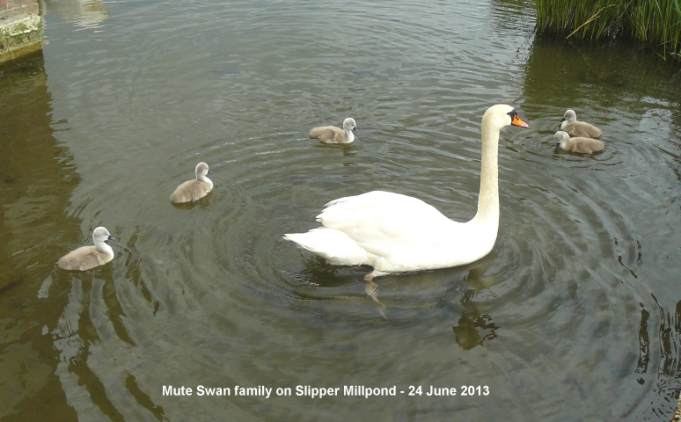
SUNDAY
JUNE 23 - 2013
English
Scurvygrass at Bosham
I sent the photo of
the Scurvygrass that I found at Bosham Harbour on June
15 and that I thought might be Common Scurvygrass
(Cochlearia officinalis agg) to Mike Shaw the
Botanical Recorder for West Sussex.
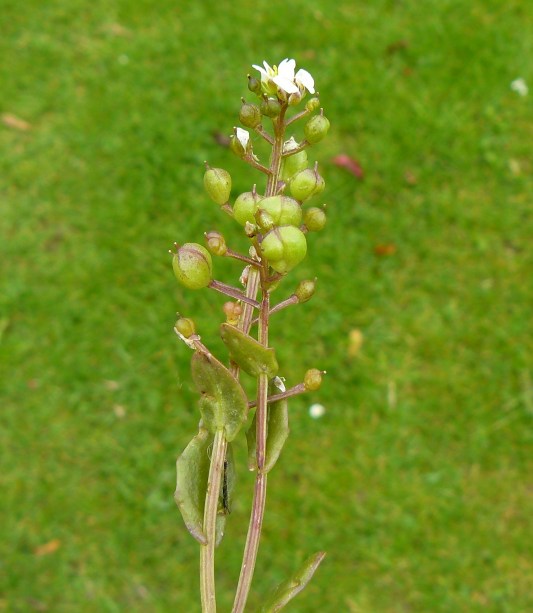
Mike replied to say he
has had no recent records for Common Scurvygrass which
was very rare here in the south. He said the crucial
characters for identification of this species
were:
(1) the shape of the basal leaves. Cuneate in
English Scurvygrass (C. anglica) and cordate in
Common Scurvygrass (C. officinalis) and
(2) the size and shape of the fruit.
Cochlearia officinalis fruit is generally
smaller than anglica (3-7mm against 7-14mm).
The fruits on the
specimen I collected originally were 7mm or less, thus
fitting the Common Scurvygrass identification.
However, I did not have any basal leaves in my
specimen, so I went over to Bosham this afternoon to
check the plants again. I had no trouble in finding
them on the eastern side of the harbour, opposite the
town, in front of a line of posts marking an area of
coastal erosion - Grid Ref: SU 80507 03286.
I found:
(1) Most of the plants I looked this afternoon had
large fruits (above 7mm) ie larger than those
on my original specimen, so I must have chosen a
particularly small plant.
(2) The basal leaves were definitely not
cordate, as required by Common Scurvygrass, but
were wedge-shaped tapering into a stalk, as
illustrated in Francis Rose's 'Wild Flower Key' (New
Ed p.219). So, clearly on the basis of both these
features the plants were English Scurvygrass (C.
anglica) and not the very rare Common Scurvygrass
(C. officinalis) .

Bumblebee
nest in roof
There is a Bumblebee
nest in the eaves of my immediate neighbour's house.
Bees have been constantly entering and leaving a small
hole under the slates of the roof. My photos of the
bees in flight show a white tail, dark abdomen and
ginger thorax.
I sent the photos to
Bumblebee expert Bryan Pinchen who confirmed the bees
as Bombus hypnorum. He added, "It is
quite likely to be nesting inside the roof somewhere,
possibly in an old bird nest. It is quite typical of
this species to nest, as it were, arboreally, hence
the sometimes used English name of 'Tree Bumblebee'.
Bryan added, "You can
reassure your neighbour that they are not harmful, not
causing any damage and in all likelihood the nest will
have completed its cycle in the next three to four
weeks - this is usually an early nesting species,
delayed a bit this year by the cooler spring. Once new
queens and males are produced (they will leave the
nest at this point), activity by the workers will
dwindle until they dessert the nest/die. They pose no
real threat from stings; unlike wasps, bumblebees in
particular need to be excessively provoked before they
even think about stinging. I only saw my first
hypnorum workers on Weds last week".
Bumblebee
on flowers
I also noticed two
worker Bumblebees with bulging pollen sacks feeding on
the flowers of a Spiraea shrub in my garden almost
immediately beneath the nest hole. I wondered if they
could be from the nest. The photo clearly shows the
white tail and two yellow bands indicative of
Bombus terrestris or Bombus
lucorum.

Bryan Pinchen
confirmed the identification as either Bombus
terrestris or Bombus lucorum but said this
bee was not from the nest in the roof, but, just
taking advantage of an easy to access food resource.
He added, "From my bumblebee studies many years ago it
was typical of workers to fly long distances for food,
even when there were suitable food resources right
outside the door. One of my marker worker B jonellus,
did a 28 minute foraging trip, returning with large
loads of snapdragon pollen, the nearest this plant
grew to the nest was 2km away, when there were
brambles etc. just a few feet from the
nest."
SATURDAY
JUNE 22 - 2013
MILLPOND
NEWS
Emsworth
Millpond
The pen swan was back
on the 'litter nest' with its young cygnet when
I passed this morning. The cygnet is starting to look
a bit scraggy around the neck - as shown in this photo
by Juliet Walker. It is probably an indication of poor
diet.; the poor little thing really needs more natural
foodstuffs than it is getting at that nest site.
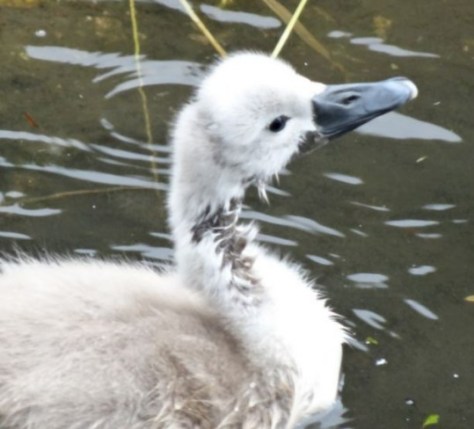
Slipper
Millpond
There was no sign of
the Mute Swan family on Peter Pond, but I found
the two parents at the far southern end of Slipper
Millpond with just 6 cygnets. I guess they lost the
other two cygnets to the Great Black-backed Gulls as
they would have needed to pass their nesting raft on
their way to where I saw them. I am not optimistic
about the others if the swans remain on Slipper
Millpond with their brood. They would be better off in
the harbour.
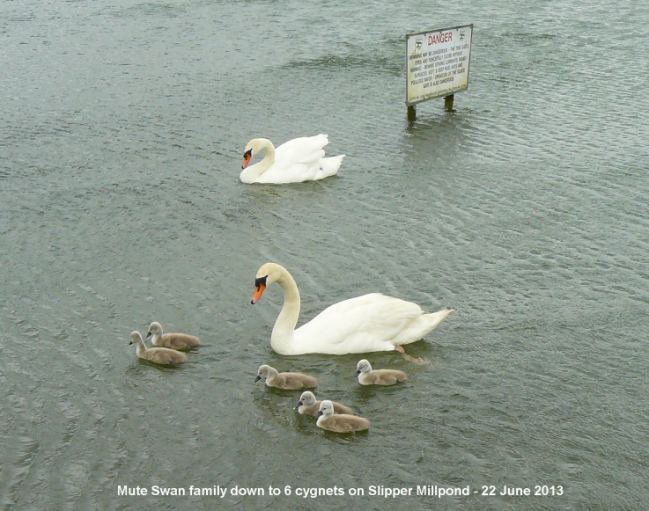
The pair of Great
Black-backed Gulls were on the centre raft of
Slipper Millpond along with their 3 rapidly growing
chicks. Fledging time is said to be 55-60 days after
hatching which should be in about another 4 weeks. But
the chicks are already flexing their wings.
Coots are back
in the nest boxes on the south raft and the north
raft, but with little real hope of producing any
young.
Sea Couch and
Red Fescue now line the footpath down the western side
of Slipper Millpond.
The Mute Swan
family with 3 cygnets from the nest on the marina
embankment was on Dolphin Lake, all looking healthy.
One of the cygnets is white - Polish - but the mother
is a normal swan with black legs and feet. .
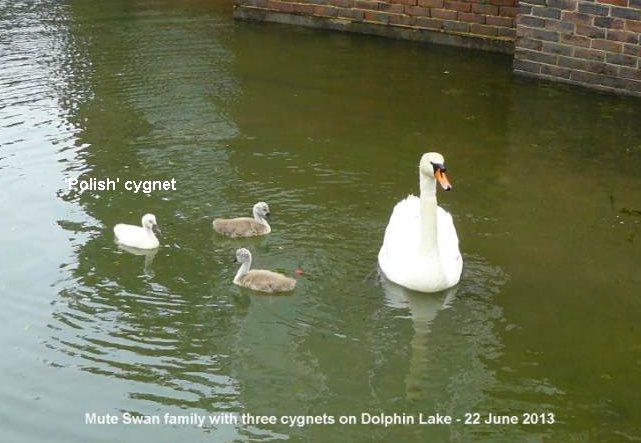
FRIDAY
JUNE 21 - 2013
BROOK
MEADOW
Great
Burnet (Sanguisorba
officinalis)
I can now confirm that
there is a small colony of six plants of Great Burnet
(Sanguisorba officinalis) on Brook Meadow at Grid Ref:
SU 75068 06131. South Hants Recorder, Martin Rand
confirmed that it is rare in Hampshire; most of the
populations in South Hants are small. Martin has no
theories about how it got there. The photo made the ID
clear enough, but he would like to see it at some
point. He may have a chance to come by the week after
next when doing a recce for another
meeting.
Blue
Water Speedwell (Veronica
anagallis-aquatica)
I found two plants of
Blue Water Speedwell flowering on the west bank of the
Lumley Stream in much the same place as in previous
years - Grid Ref: SU 75155 06054. The flowering spikes
were relatively short suggesting it is the pure form
of Blue Water Speedwell (Veronica
anagallis-aquatica) and not the hybrid with Pink
Water Speedwell ie Veronica x Lackschewitzii.
This identification is supported by an old record of
the pure strain of Blue Water Speedwell in The Hants
Flora in this exact location in Emsworth in 1982.

One way to distinguish
the hybrid from the pure form of Blue Water Speedwell
is by counting the flowers on the longest raceme. The
Plant Crib 1998 (p.263) gives a mean of 25 flowers
(range 15-40) for the pure form and a mean of 60
(range 30-90 for the hybrid. I shall need to look
again at these plants as they have not yet opened
fully.
Other
plants
Four plants of
Brooklime were flowering in the same area as
the Blue Water Speedwell Grid Ref: SU 75152 06055. The
Brooklime is similar to the Blue Water Speedwell, but
the flower spikes are shorter and the flowers deep
blue and the leaves are oval not lanceolate. Water
Dock is in flower in the same small area on the
west bank of the Lumley Stream. I also found just one
flower of Celery-leaved Buttercup in the
"Lumley puddle" area. Ref: SU 75141 06017.
Grasses
workshop
I had the very good
company of three ladies (Lesley Harris, Jennifer Rye
and Caroline French) for a grasses identification
workshop session on Brook Meadow this afternoon. I
introduced the main features of grasses used in
identification. Then we went through the meadow
examining and identifying (and admiring) the various
grasses, sedges and rushes on show! I have recorded 22
of the 33 grasses on the Brook Meadow list so far this
year.
Meadow
Barley
The most recent find
was just four spikes of Meadow Barley on the west path
through the north meadow. There must be more
somewhere, if only we can find them among the mass of
other grasses.
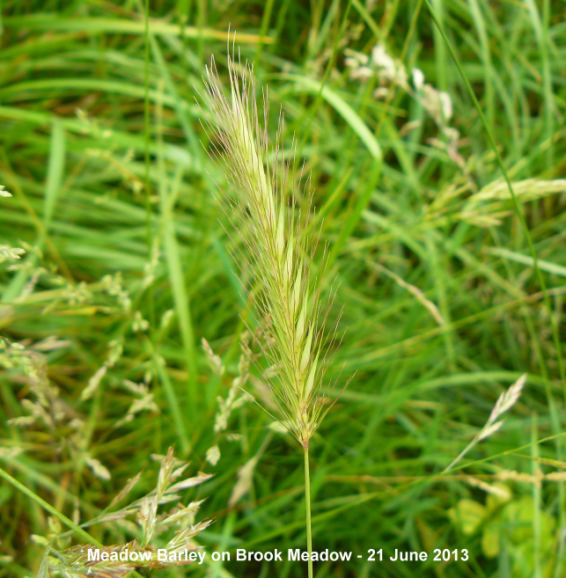
Plicate
Sweet-grass
I only found today was
a single spike of what I assume is Plicate Sweet-grass
(Glyceria notata) in the "Lumley puddle" area at Grid
Ref: SU 75141 06017. I have only previously seen this
on Brook Meadow growing in the River Ems. I did not
pick it!!
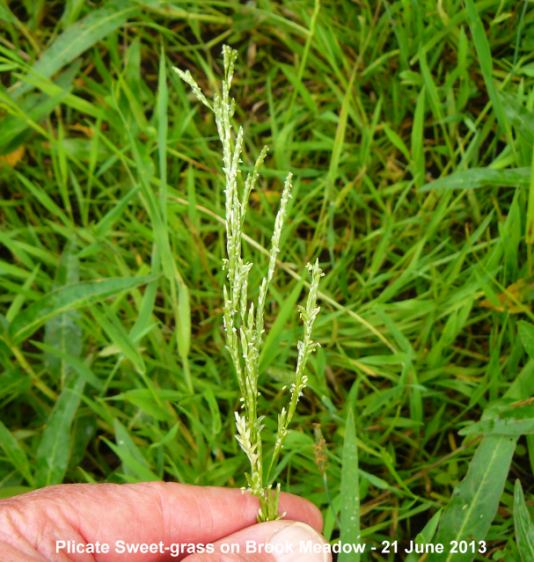
Other
grasses
Other grasses of
interest were the Festulolium Hybrids
(Festulolium loliaceum) along with its 'parents'
(Meadow Fescue and Perennial Ryegrass) on the north
eastern path close to the seat by the willow tree.
Grid Ref: SU 75089 06158.
On the way to the
meadow I found a good growth of Water Bent on the
pavement outside house number 24 Victoria Road.
Toad
Rush
Toad Rush is also out
in the "Lumley puddle" area near the Lumley gate. I
was surprised to find another patch of Toad Rush on
the side of the north east path through the north
meadow. This is a completely different habitat to the
"Lumley puddle" area, though Rose does say it occurs
on the bare moist soil of paths, which is exactly
where I found it.
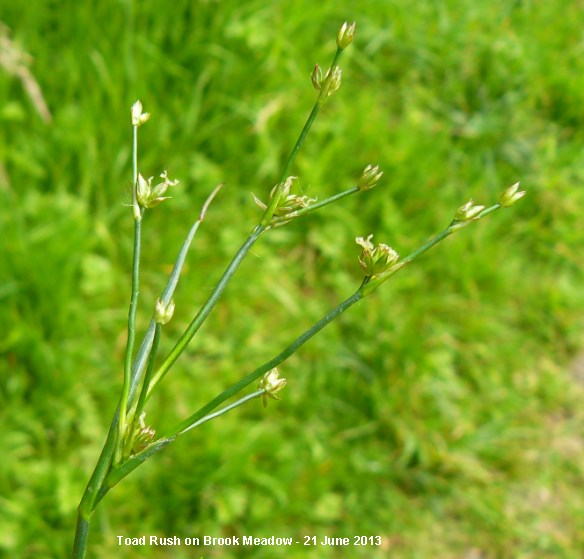
Small
Tortoiseshells
I saw at least two and
possibly three Small Tortoiseshell butterflies as I
was walking up the north west path towards the north
gate. Each one settled for a few seconds on the path.
I did not notice the first two until they flew, but I
managed to get the binoculars on the third one, but
could not manage a photo. These were not the first on
Brook Meadow, as I saw one on May 7.
HAYLING
OYSTERBEDS
Chris Cockburn
provides the latest up date: "Things are still looking
good at the Oysterbeds. The first of the black-headed
gull fledglings are now making short and weak flights
over the Oysterbeds' lagoon. The fledging date is very
similar to that in 2012, despite the cold weather this
spring. There is still a multitude of black-headed
gull chicks on the islands - estimating the numbers of
successfully fledged gulls will probably prove be a
bit of a challenge. Mediterranean gull chicks are
often showing well close to peg 'Q' on the curved
(easternmost) island.
If some of the common
terns really have been sitting on eggs since the last
bank holiday, the first eggs should be hatching within
the next few days. Hopefully, any tern chicks will not
be targeted by the Mediterranean gulls that have been
visiting the site to feed on eggs and small
black-headed gull chicks. Late news: Common tern eggs
started hatching yesterday (thanks Phil) - so more
cute chicks to view. The most obvious chicks are to
the left of the furthermost 'F' peg (two chicks per
pair). There were lots of good sized silvery prey fish
being brought in today. Some common tern/black-headed
gull bill-to-bill clashes looked a bit dangerous; but
nothing compared to treatment handed out to
black-headed gull chicks straying into wrong
territories. Next week's big spring tides have the
potential to flood out the oystercatcher nest on the
western end of the linear (westernmost) island.
Although some little terns have been regularly seen,
even fishing in the lagoon, it seems most unlikely
that they will nest on the newly imported shingle this
year. However, little terns are using the shingle
recharge on South Binness Island.
There are reports of
Bee Orchids on the Billy Trail (south of the Hayling
Halt car park)and insect s are becoming more numerous
(at least one Painted Lady butterfly was seen on 19
June)
WEDNESDAY
JUNE 19 - 2013
WAYSIDES
NEWS
Railway
Wayside
The wayside is really
developing nicely with a variety of wild flowers on
the embankment below the new ramp. There is also a
good growth of grasses, mostly Perennial Ryegrass, on
the lower rubble area.

New plants for the
site: Oxeye Daisy, Rough Hawkbit with a single
bright yellow daisy at the top of very hairy and
leafless stem rising from a rosette of leaves. There
was a very attractive Goat's-beard seedhead in
full bloom! Numerous plants of Wild Carrot are just
starting to open its flowers.
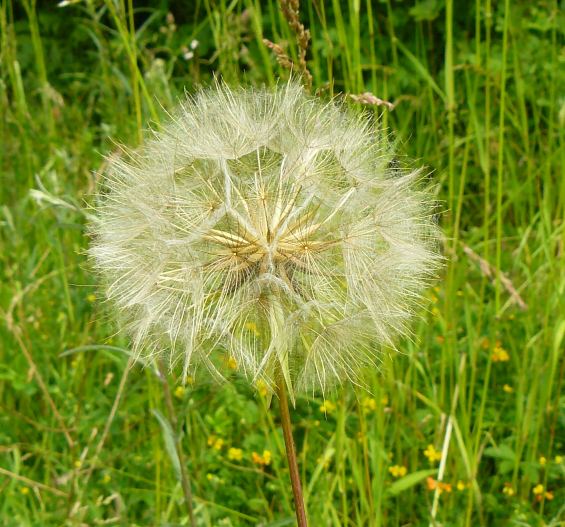
As for insects, there
were several Bumblebees feeding on the flowers,
including a Bombus pascuorum) on Tufted Vetch. I saw
my first Meadow Brown butterfly of the year, a
male showing only its underwings with a single black
spot. A Common Blue was also flying on this
wayside.
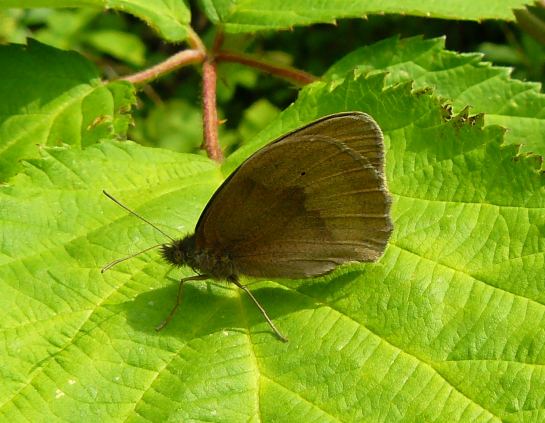
Christopher
Way verge
There are just two
flowering Wild Clary plants on the mown verge
to the west of the main wayside. There are in fact
about 10 plants in all on this verge. So, they have
not all gone!

Westbourne
Open Space
The female Ash
trees look perfectly healthy and are loaded with
bunches of keys. So no sign of any Ash die back here.
Emsworth
Recreation Ground
The first of the
Creeping Bent-grass is now out on the grassland
behind the bowling green. It can easily be recognised
by its red flushed tightly closed panicles. Lesser
Stitchwort is also flowering on the grassland area.
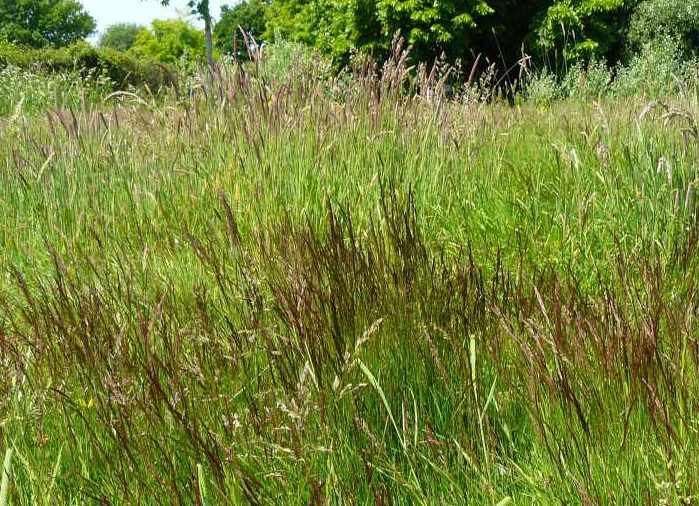
GARDEN
BIRDS
Male and female
Bullfinches were on the feeders at around
lunchtime today. It is amazing how frequent these
birds are this year. Four Swifts were screaming
around the houses in Bridge Road.
MILLPOND
NEWS
The pen was off the
'litter nest' at long last and was on the main
millpond with her cygnet. Let's hope she stays there,
though I would not hold my breath over this! The Coot
is back on the 'tower nest' which was swamped by the
high tides.
The Mute Swan family
on Peter Pond is still intact with 8 very healthy
looking cygnets.
TUESDAY
JUNE 18 - 2013
EMSWORTH
There appear to be
two Great Burnet plants on the orchid area
growing close together. The taller one has three four
heads and the shorter one two. I marked the spot with
two conspicuous twigs.
The Mute Swan
family on Peter Pond with all 8 cygnets was in the
water beneath the seat when I passed this morning. The
parents were being fed with bread.
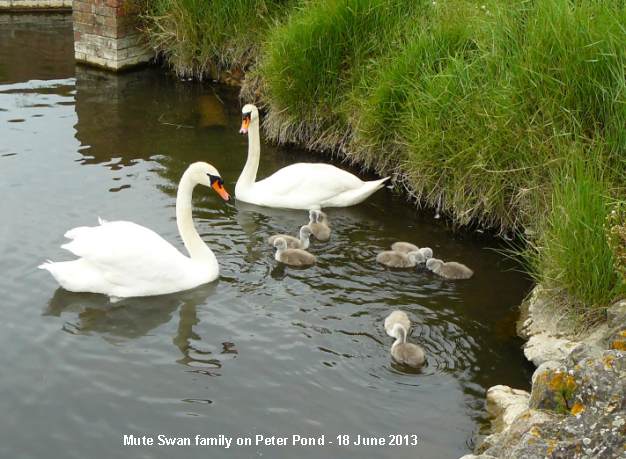
The Great
Black-backed Gulls have allowed two Cormorants to
share their raft on Slipper Millpond.
Patrick Murphy had a
male Bullfinch yet again on his garden seed
feeder today. They do seem to be coming into gardens
more often this year. Shortage of natural foods?
COMMON
SCURVYGRASS
On June 15 while
walking round Bosham Harbour I found some
white-flowered plants which I thought at first were
English Scurvygrass on the roadside embankment on
eastern side of the harbour opposite the town. I
brought a sample home and on closer inspection they
appeared to fit the description of Common Scurvygrass
(Cochlearia officinalis agg) in my guides. In
particular, the upper leaves were clasping the stem
and the pods were rounded. See photo.

In English Scurvygrass
the leaves narrow gradually into the stalk and the
pods are flattened. However, Common Scurvygrass is not
found in SE England according to the local floras, so
presumably that rules that out! It must have been
either Danish Scurvygrass or English Scurvygrass.
However, South Hants
BSBI Recorder Martin Rand thought the photo certainly
looked like Cochlearia officinalis. He says this is
not completely impossible as it was recorded
(correctly or not) in the eastern part of Chichester
Harbour in 1986. He thought Mike Shaw the West Sussex
recorder would be very interested to follow it up. So
I have sent a photo of the plant to Mike with
directions as to its location.
MONDAY
JUNE 17 - 2013
WAYSIDES
SURVEYS
Jane Brook and I
surveyed the waysides in north Emsworth this morning.
Here are a few observations of interest.
On the Southleigh Road
(west) wayside we found lots of Ladybirds in
various stages of development including larval,
pupal and the newly emerging Ladybird which as the
following photo shows is yellow with the spots showing
through.

Here
is the life cycle of the Ladybird
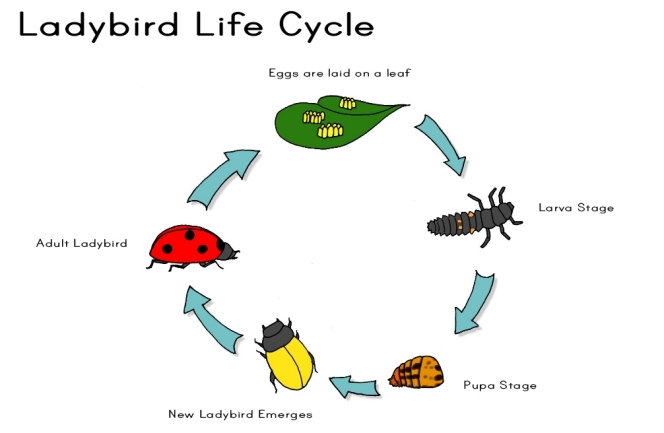
We also found a bee
feeding on a White Dead-nettle flower. It looked a
bit like a solitary bee, so I sent the image to Bryan
Pinchen for identification. Bryan says it's a worker
Bombus pascuorum, probably a first brood
worker hence the small size.
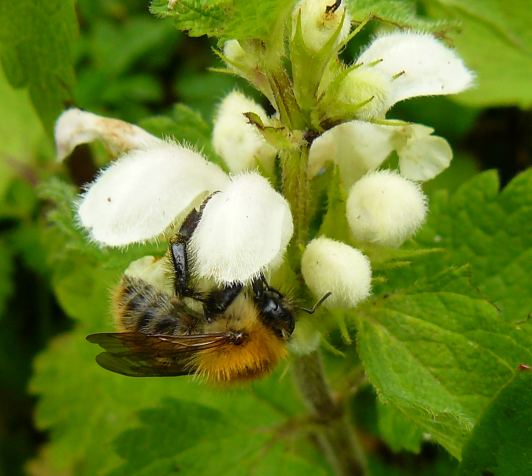
There were a large
number of Ash saplings along the Southleigh
Road (west) verge, most of which were probably
seedlings from the mature Ash trees on the other side
of the road. However, some appeared to have a
substantial base suggesting a coppicing effect from
the regular cutting. Both the Spencer's Field site and
the Barwell Grove path have substantial Common Elm
trees without any signs of disease. The latter
path also has a growth of Elm suckers. Timothy
grass is now showing flower spikes.
BROOK
MEADOW
Great
Burnet (Sanguisorba officinalis)
Following a query from
Ralph Hollins, I checked what I thought looked like a
red buttercup seedhead on the orchid area of Brook
Meadow (previously photographed on June 14). I was
wrong it was certainly not a buttercup. In fact, it
looked like Salad Burnet with the flower heads
just starting to flower. If so, this would be a first
for Brook Meadow. Here are photos of the flower head
and leaves. I would appreciate confirmation.
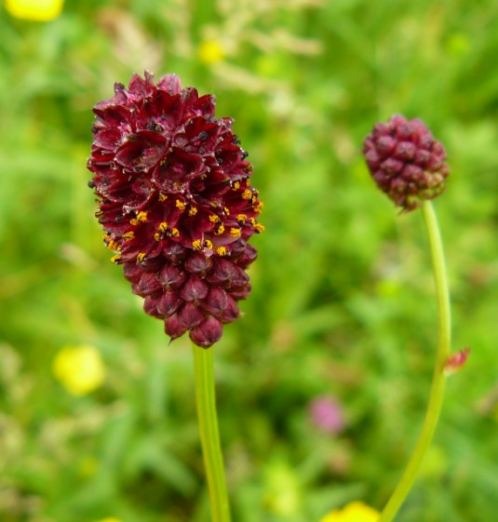

Martin Rand confirmed
that the red headed plant was Great Burnet
(Sanguisorba officinalis), or something close,
because:
1. It's possible to see the (dark) remains of anthers
in the upper florets - the upper flowers of Salad
Burnet (S. minor) are all female.
2. The styles are disc-shaped and sunk at the bottom
of the flower, not feathery and protruding.
3. The lateral leaflets are stalked. That said, the
stalks aren't that long and the leaflets are a
slightly odd shape for Great Burnet (S.officinalis)
(rather pointed), but they'd be an even odder shape
for Salad Burnet (S. minor). There is a cultivar
'Thundercloud' that seems to have more this leaf
shape.
4. Also the shape and colour of the flowering head is
Great Burnet (S.officinalis).
Martin added "If you haven't seen it before at Brook
Meadow, it's likely to be a recent introduction. As a
native in South Hampshire it's confined to the New
Forest where it's one of several "hay meadow"
constituents of base-rich flushed heathland in the
south of the Forest."
Other flowers to catch my
eye this afternoon were the red flushed panicles of
Reed Canary-grass and a great display of Yellow
Flag north of the causeway.

Yellow
Flag in flower above the causeway on Brook Meadow
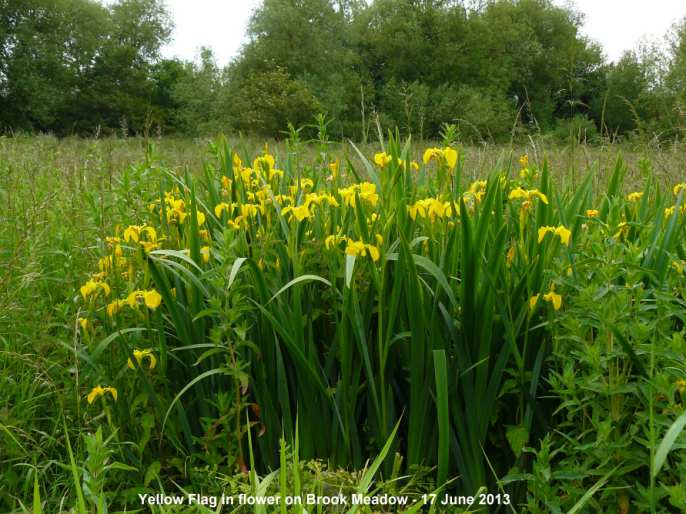
For
earlier observations go to . . June
1-16